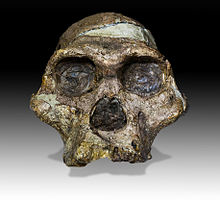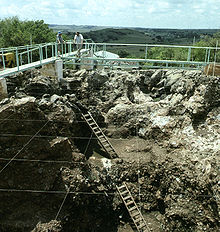- Mrs. Ples
-
Mrs. Ples 
Catalog number STS 5 Common name Mrs. Ples Species Australopithecus africanus Age 2.05 mya Place discovered Sterkfontein, South Africa Date discovered 18 April 1947 Discovered by Robert Broom, John T. Robinson Mrs. Ples is the popular nickname for the most complete skull of an Australopithecus africanus specimen ever found in South Africa. Many fossils of this species, which are considered to be the distant relatives of all humankind, have been found in the Sterkfontein area, in what has been designated the Cradle of Humankind World Heritage Site, which is situated approximately 70 kilometres southwest of Pretoria. Mrs. Ples was discovered by Dr. Robert Broom and John T. Robinson on 18 April 1947. The catalog number for Mrs. Ples is STS 5.
The nickname Mrs. Ples was derived from the scientific designation Plesianthropus transvaalensis (near-man from the Transvaal), initially given to the skull by Dr. Broom; the nickname itself was coined by young coworkers of Dr. Broom.
The sex of the skull is not completely certain and so Mrs. Ples may in fact be Mr. Ples. In addition, X-ray analysis of the roots of the teeth of Mrs. Ples has suggested that it was a sub-adult, so a designation of Miss Ples or Master Ples is also possible.
Some experts have suggested that a partial skeleton, known only by its catalogue number of STS 14 that was discovered in the same year, in the same geological deposit and in proximity to it, may belong to this skull. If correct, this would make Mrs. Ples the South African counterpart to the famous Lucy fossil.
The fossil has been dated by a combination of palaeomagnetism and uranium-lead techniques to around 2.05 million years.
In 2004, Mrs. Ples was voted 95th in the SABC3's and e.tvs Great South Africans Top 100 list.
See also
- List of human fossils
- List of hominina (hominid) fossils (with images)
- Taung Child
References
- Herries, A.I.R., Shaw, J. 2011. Palaeomagnetic analysis of the Sterkfontein palaeocave deposits; age implications for the hominin fossils and stone tool industries. J. Human Evolution. 60, 523-539.
- Herries, A.I.R.., Hopley, P., Adams, J., Curnoe, D., Maslin, M. 2010. Geochronology and palaeoenvironments of the South African early hominin bearing sites: a reply to ‘Wrangham et al., 2009: Shallow-Water Habitats as Sources of Fallback Foods for Hominins’ Am. J. Phys. Anthro. 143, 640–646.
- Images of STS 5
- Tattersall, Ian, Schwartz, Jeffery (2000). Extinct Humans. Westview Press, Boulder CO. pp. 65–66. ISBN 0-8133-3482-9.
External links
Categories:- Anthropology
- Archaeological artefacts
- History of South Africa
- Hominin fossils
- Specific fossil specimens
Wikimedia Foundation. 2010.

